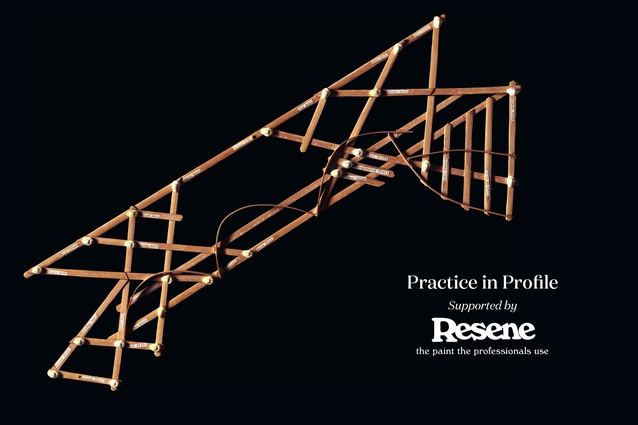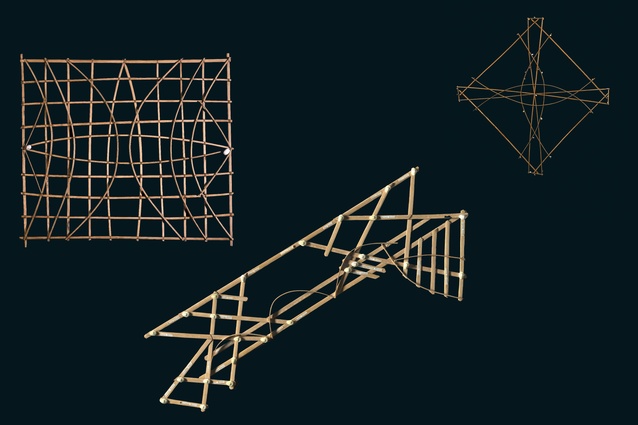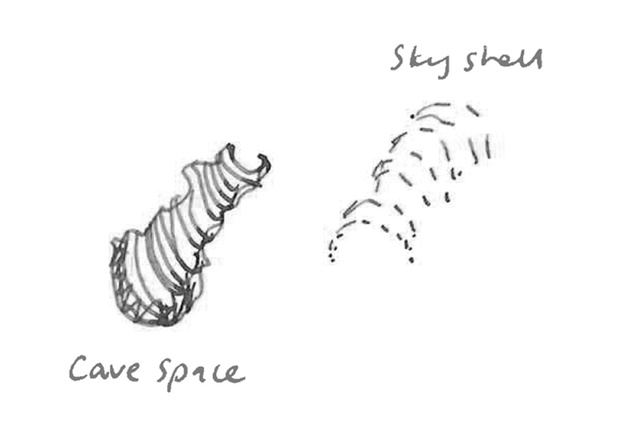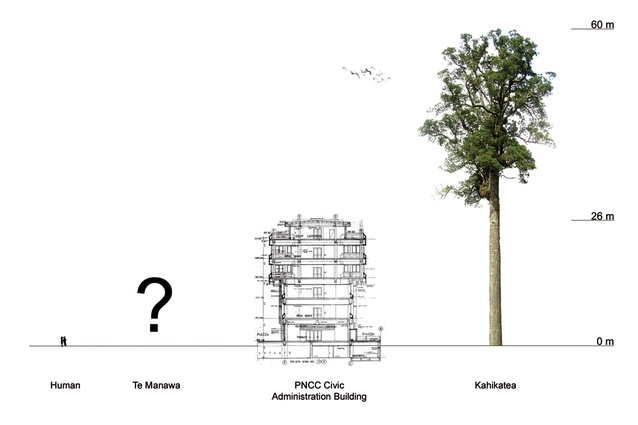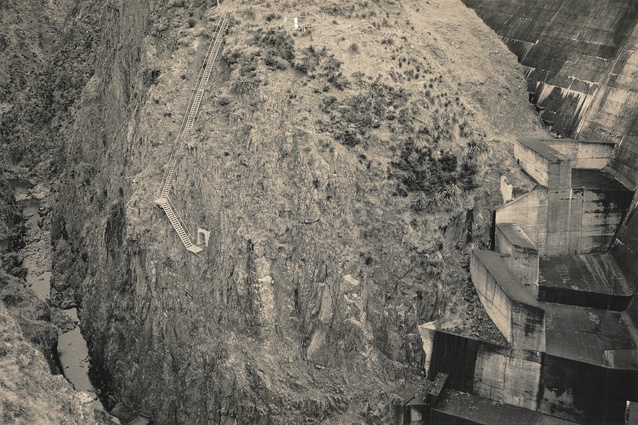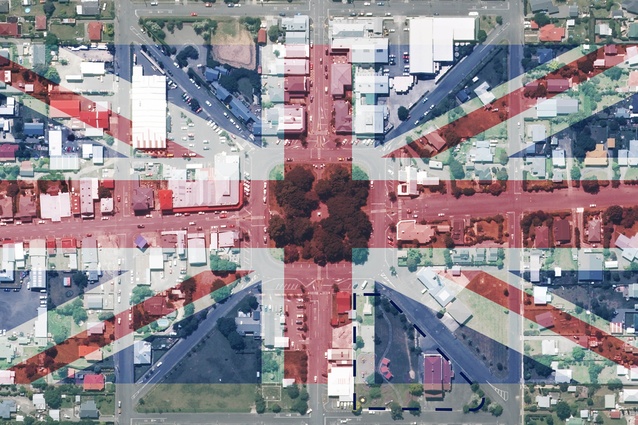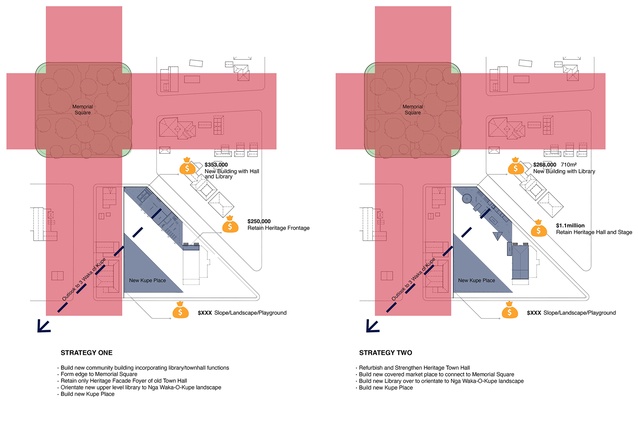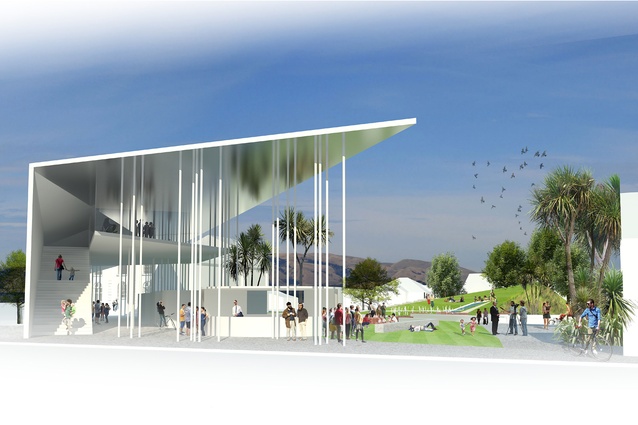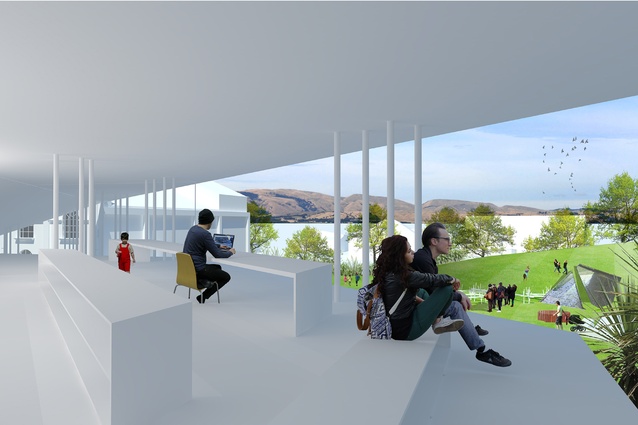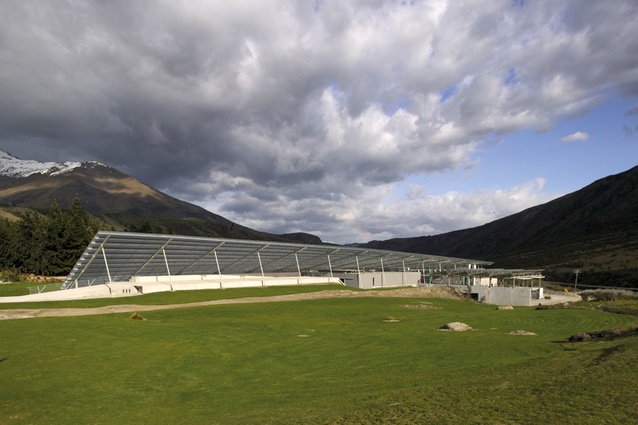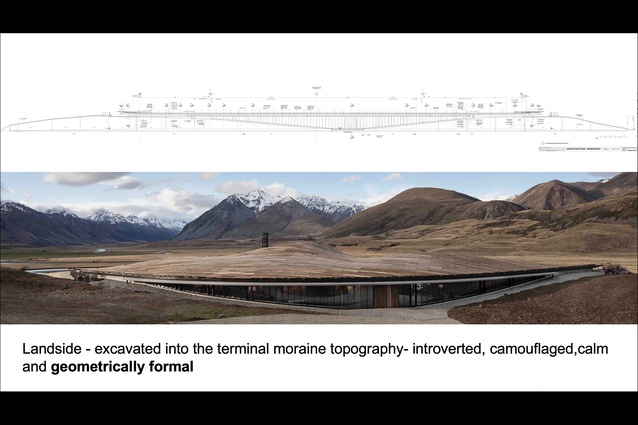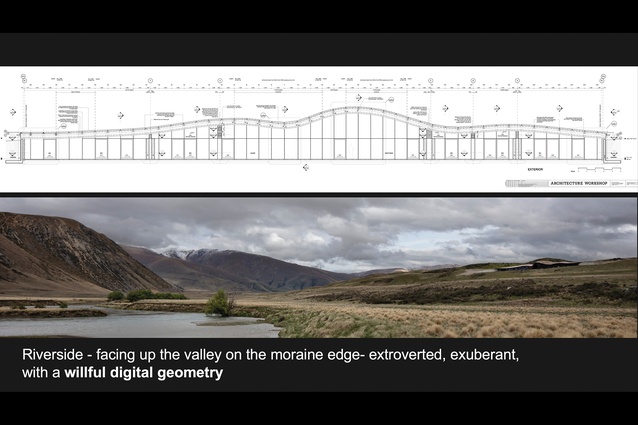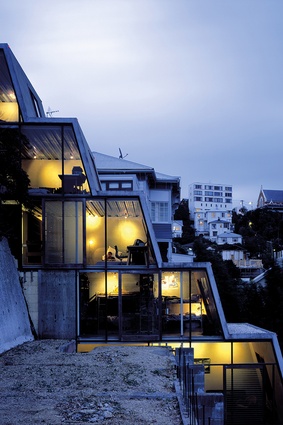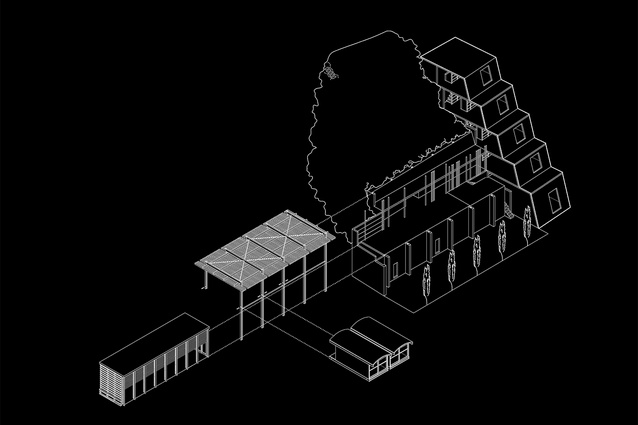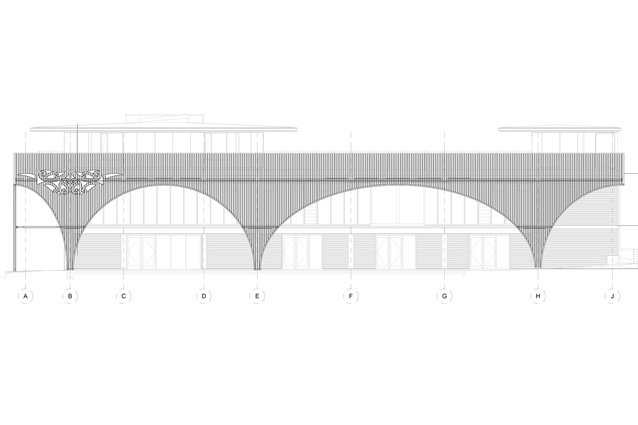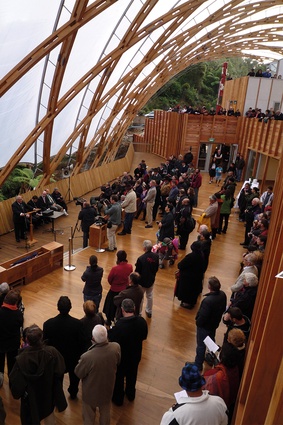Practice in Profile: Awaiting the chisel of the mind
Christopher Kelly reflects on wilfulness and how Architecture Workshop navigates its way by a series of design intents.
As the cliché goes, the concept – usually a ‘divine moment of inspiration’ by the solemn architect – is quickly transferred to whatever is handy before the insight fades: the sketch on the napkin or a primal scribble in a revered sketchbook. It becomes a shorthand reference for the project. I do it myself (see image 3).
When I am contributing to a student design crit, I try to keep my own opinion – my likes and dislikes – away from the discussion (well, as much as one consciously can). I try to use the student’s own words, their own terms of reference, to judge how well they have achieved their own intent. How well did they solve the problem that they themselves have made?
Architects are trained to invent a ‘narrative’ for each of ‘their’ buildings. It’s the story we tell our client, and often ourselves, about the reasoning for our decision-making. Often, lately, I wince as our ‘architectural narratives’ sound more and more alike – the parody of architecture speak.
Pete Rice, a renowned structural engineer, no longer with us, argued that the supposed rationality of a project’s genesis is simply the wilfulness of the individual architect falling back on their standard repertoire, personal values and problem-solving techniques to create a design.
An idea gains more heft when it references a series of design intents that provide a decision-making framework. The input of valued consultants and client feedback overwrites the framework as it iterates through successive design cycles. New constraints, viewed positively, can often distil a project further. Over time, the authorship becomes truly collaborative and attributable to the larger group.
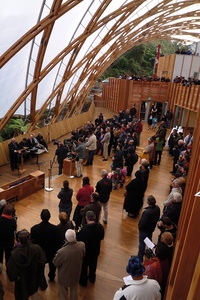
The idea framework becomes a sort of condensed shorthand, much like Polynesian navigation ‘stick maps’ give a bearing to sail to when faced with the unknown immense ocean. (See image 2.)
What are Architecture Workshop’s ‘stick maps’ that aid our navigation through a project when faced with the similar uncertainty of the blank sheet of paper?
Stick Map One: Chisel of the mind
Jim Baxter used to turn up randomly and barefoot to recite poetry at my secondary school assembly. The incredibly determined pacifism of Archibald Baxter, Jim’s father, the commune Jerusalem on the Whanganui River and Baxter’s own rich literary life give him currency in our whānau. For instance, Baxter wrote an essay called Conversation with an Ancestor, where he meets a ghost of his great-great-grandfather and the ghost asks Baxter, “Do you still wear the tartan?” Baxter explains: tartan is “a sign of contact with the land held in common” – and to which he replies, “either I wear it or else go naked”.
Accordingly, the first two inspirational lines of James K. Baxter’s poem New Zealand had resonance for a young architect leaving good prospects in Europe to set up an architecture practice in Aotearoa.
“These unshaped islands…” The new world, raw and full of opportunity but what have we done? “On the sawyer’s bench…” We have “felled the mighty 60m-high lowland bush to transform the wetlands for pasture”, as referred to by Geoff Park in Theatre Country (see image 4).
As Park points out, Barrar’s camera “leads him to the landscapes we create when we harness the earth to drive our demanding lives” (see image 5).
“The chisel of the mind.” Aotearoa’s islands are to be shaped but will the new transformed shapes be an improvement on the original? Some research and introspection is required. Have we looked closely enough at the situation?
Up until the end of the Baroque era, landscape and architecture were viewed as one discipline. From the 1750s on, there started to be a separation. Robert Morris, an English 18th-century surveyor and architectural theorist, referred to the site as ‘situation’ and argued not only against landscape and architecture being separated in his 1734 Lectures on Architecture, he emphasised that “the site was an external source for architectural order”.
One of the more stimulating tasks of architectural life in Aotearoa is looking for clues in the situation/landscape to form a conceptual framework for a project.
When we select relevant precedents to benchmark our architectural and urban design response, Architecture Workshop is concerned that the result is authentic to Aotearoa. We call on our architectural instinct honed by growing up here in the country and living and working in different parts of the globe.
An example of Architecture Workshop’s Stick Map One thinking is seen in the competition for a new Martinborough Community Centre. At the urban design level, the design intent was to reinforce the unique Union Jack-inspired central square and balance the colonial history with a stronger connection to iwi via the surrounding Nga Waka ō Kupe landscape. This Ngāti Kahungunu orientation was further enhanced with the creation of a new, sheltered public space for a local produce market.
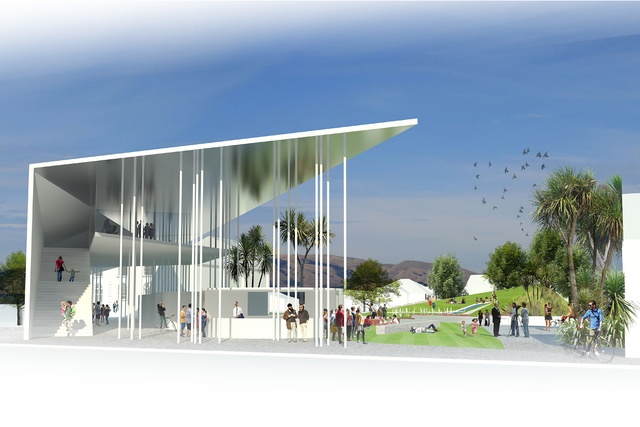
At the architectural level, the design intent was to offer two strategies testing our assumption that the community would gain more amenity from a well-designed new building than from doing up an old building in the wrong place.
The Martinborough town plan (population 1600) was laid out around a central Memorial Square in the pattern of the Union Jack, by founder Johnny Martin, a feisty Belfast-born MP who challenged the larger runholder families to split their land (see image 6).
Architecture Workshop developed two strategies to test the best civic amenity proposal. The preferred Strategy One used the budget more efficiently to build a new 200-seat community hall/library rather than to refurbish and fit these functions into an old town hall that requires further expensive re-strengthening (see image 7).
The placement of the new building on the diagonal reinforces the edge of Memorial Square on one side and shelters new public market space on the other side (see image 8).
The new community centre orientates users to the iconic hill country silhouette of the Nga Waka ō Kupe, helping also to re-align the identity of the town with the local history of Ngāti Kahungunu. The library overlooks a new raised public space, inspired by ‘Kupe’s Sail’, a Wairarapa coastal rock formation marking where waka landed around 1100AD (see image 9).
Stick Map Two: Lightweight/heavyweight
In our projects, Architecture Workshop has invariably searched to discover a geometrical response that derives from the larger built/unbuilt context and a spatial response that amplifies the special qualities of the place.
We have always been intrigued by Peter Buchanan’s Pacific Rim essay in the Architectural Review (August 1991) that suggested:
People who have migrated by sea, such as those around the Pacific rim, have developed as more lightweight tension cultures as opposed to heavier compression cultures such as in Europe, where buildings are constructed of stone and brick in order to defy nature and time. Rather than resist nature, tension cultures build with lightweight renewable elements to bend with the earthquakes or wind.
Also, referencing Gottfried Semper’s (1803–1879) framework, we put these light and heavy elements in opposition – the lightweight roof in counterpoint with a heavyweight wall or base.
In the Ted McCoy 2018 lecture series Three Rooves, we showed how Stick Maps One and Two influenced the design process and the tectonic development for three Architecture Workshop projects: Peregrine Winery, Waitomo Glowworm Caves Visitors Centre and The Lindis, then under construction.
Peregrine Winery is a particularly good example of this binary methodology responding to the landscape. The translucent, light steel roof over the pre-cast concrete wine cellar excavated into the ground provides an event stage that opens towards the Crown Range ridge line. Rotation of the structure alludes to the movement of a bird’s wing – a narrative we emphasised to enhance the Peregrine wine brand (see image 10).
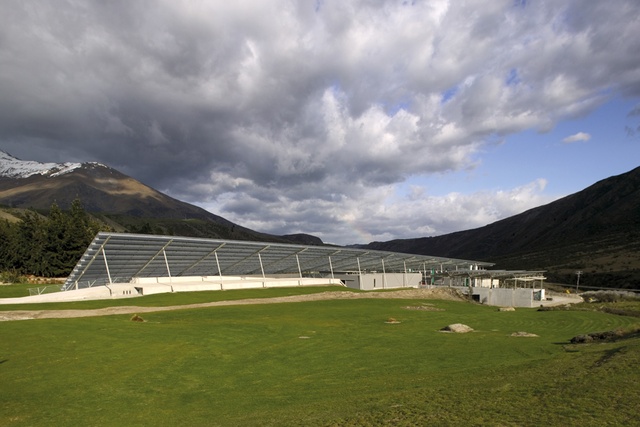
A year later, when I was preparing the 10-minute presentation of The Lindis for the 2019 World Architecture Festival final, I wasn’t satisfied that the Stick Map Two rationale fully explained the project’s genesis. Standing in front of 300 of your global peers focuses the mind.
In answering our question of how might we address the problem of the isolated building in the beautiful scenic New Zealand backdrop, the strategy for The Lindis was to make the building an attribute of the site: to bind the building with the land.
Instead of the heavy/light binary, I realised, in discussion with Kerstin Thompson, that the riverside/landside binary that had generated the planning and the section more concisely and authentically explained the project (see image 11 and 12).
In my final presentation at the World Architecture Festival last year, I explained: “But this is not simply a camouflage building. It is an unusual building in that the large roof has only two elevations. Each elevation has a different character that responds to the adjacent situation.” This led me to examine whether or not the binary driver, over the years, had blinkered Architecture Workshop’s thinking. The ‘false binary’ discussion has been in the news. “Should we reduce greenhouse gas emissions or create jobs for the unemployed?” A false binary is a choice between two hypothetical extremes.
A false binary has become the bane of modern democracy, forcing phoney debates about brutal choices while also stifling public debate about creative solutions.
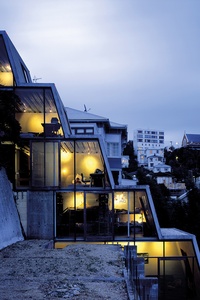
Perhaps 224 Oriental Parade (see image 13 and 14) didn’t need the additional stage of the lightweight ‘tent’ to complete the dwelling (and to contrast with the heavyweight ‘cave’). Patrick Bingham-Hall, our photographer at the time, thought the cave was pretty good by itself. I think, with hindsight, he is correct. It was an option that, in my wilfulness to examine the duality, I never considered.
Stick Map Three: A relationship of equality
Finally, to finish, I re-read our own Institute’s 2005 centennial year publication, Exquisite Apart, edited by Charles Walker, much as when, as an older adult, you might reread a classic novel and discover an entirely different book from the one you experienced the first time.
I also reread my own contribution, Second Nature, and Iñaki Abalos’ words about the notion of an inherited European landscape:
A type of landscape that is looked at, used and exploited – viewed voyeuristically if you like. In many first-world countries, there is now no nature – at least in a way it was understood prior to the modernists: original, wild, virgin. The earth has never been so systematically plundered as in the century of modernism.
A relationship of equality was never established. We have learned to see the physical environment from above: in plan, sufficiently far off, so as to abstract it so it can be utilised for outside interests objectified into movement systems and separate use zones. It is a question of re-establishing the framework of contemporary society’s public space, the space par excellence of the polis. The environment is a cosmic forum from which to redescribe the totality of the received inheritance, a consensual democracy extended to the planet. It is an entropic world of extreme fragility.
The Iñaki quote seems even more pertinent in these times, with the now-exposed failure of neoliberal politics, the erosion of public institutions and COVID-induced disorder. Architects will have to defend the importance of cities and especially public space, finding balance and establishing relationships of equality with the planet and with each other.
The new Bulls Community Centre (see 15) will be a hybrid functional space, providing a learning centre, library, regional hall, Plunket and community rooms, as well as a roof terrace public space that looks out over the old serpentine river bank to the country on one side and the new public space at the original crossroads on the other side.
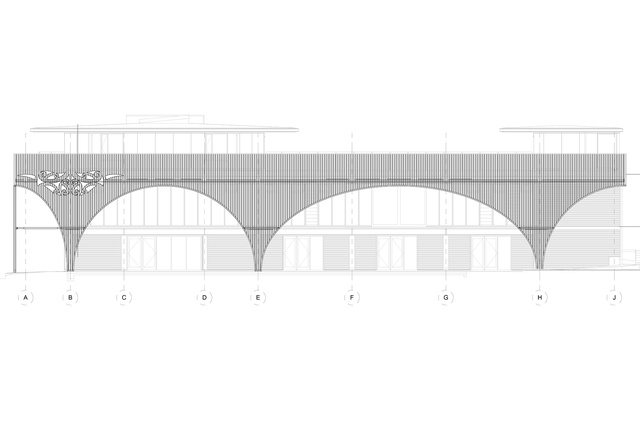
The external ‘carapace’ around the building adds an external layer of shelter as well as solar protection to the interior. The form of the carapace alludes to river crossings, bridges and the many taniwha and protectors living on the Rangitīkei Awa. Len Hetet of Baked Design has grabbed the baton and run hard. In discussion with Ngāti Parewahawaha and Ngāti Apa, he has added what we call ‘a watchful eye’ that further embeds local meaning into this #gatheringplace. The eye animates the carapace, enhancing its advocacy for a ‘relationship of equality’. As part of the installation, iwi write:
Bring us together under the umbrella of peace,
Where the land rolls into the ancestral water of the Rangitīkei,
We acknowledge you Papatūānuku (earth mother) and Ranginui (sky father),
To nourish us, sustain us, and bring us together as a people.
On reflection
The three ‘stick maps’ outline core interests and, considered together, they all contribute to the overarching purpose of Architecture Workshop’s practice – to find an authentic response to our situation (by discovering cues from the landscape/context) on which to base the project’s key intents.
Chisel of the mind is about transformation of what we find – the situation – through architecture.
Lightweight/Heavyweight is about the tectonic and use of countering lightweight with heavyweight to speak of construction but, perhaps, also towards an antipodean culture.
A relationship of equality is a more recent stick map realisation, in the light of burgeoning global inequality, of the need to bring differences together under the umbrella of architecture and of the ways in which architecture of place can bring people together (see 16).
To shape these islands in the future, we will need to explain more explicitly how the actual design – form, layout, flow of functions and adjacencies, language – can speak to and accommodate more and diverse peoples and stories.
References
Geoff Park, Ngā Urora, VUW Press, 1995
Geoff Park, Theatre Country – Essays on Landscape and Whenua, VUW Press, 2006
David Leatherbarrow, Topographical Stories, Robert Morris, ‘Lectures on architecture’, 1734, University of Pennsylvania Press, 2015
Charles Walker (ed.), Exquisite Apart; 100 Years of Architecture in New Zealand, NZIA, 2005
Peter Rice, An Engineer Imagines, Artemis, 1998
‘New Zealand’ by James K. Baxter reproduced with the permission of the James K. Baxter Trust.

